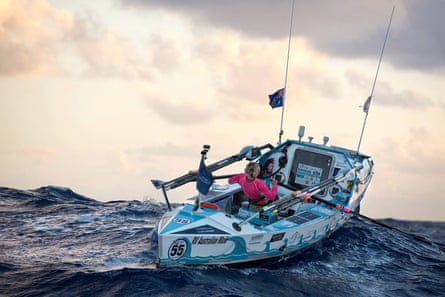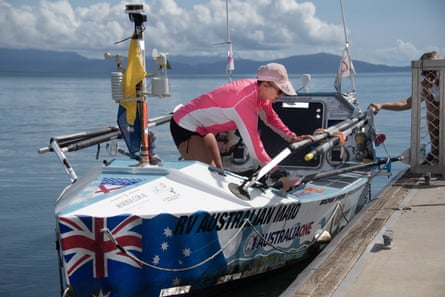After rowing alone across the Pacific Ocean, dodging five hurricanes and four cyclones and surviving a shark leaping into her boat, Michelle Lee was to end an epic 240-day journey at the tropical north Queensland city of Cairns on Monday.
Fanfare, loved ones, a stack of pancakes and a hot shower were awaiting – not to mention her first footsteps on dry land since she paddled out of Ensenada, Mexico, on 8 August last year.
But strong outgoing tides and the Great Barrier Reef had other ideas.
Instead, the 50-year-old massage therapist from Sydney’s north-west was forced to stagger her journey through the largest living structure on Earth over several days. She would rise at 2am to work the tides and passages on a revised route that saw her land 58km north of her intended destination, at the palm-fringed resort town of Port Douglas on Wednesday.

There, shortly before 10am and after paddling for about 14,000 kilometres, Lee landed her boat – the Australian Maid – making her the first woman to row solo and unassisted across the Pacific.
Sign up for Guardian Australia’s free morning and afternoon email newsletters for your daily news roundup
“The last bit was a bit of a battle,” she told waiting press. “But it’s the story of my life: winds, currents, tides, everything against me, often I had all of them doing different things. So, adversity, I guess, you got used to it out there.”
Lee, though, did not just have to face up to the challenge of extreme physical exertion.
She faced stretches of up to nine days confined to a cabin “no bigger than being under your kitchen table” as winds and waves raged around her.
In her confinement, Lee learned “the art of patience”. She played a ukulele, made a pudding, cut herself a mullet and listened to audiobooks – her library ranging from self-help author Joe Dispenza to meditation guru Jose Silva and romance novelist Maddison Michaels.

Not that she was ever totally alone out there on the Pacific. Lee was followed by two large sharks for weeks.
Later, four baby sharks started swimming beneath her 7.7m carbon fibre boat. Lee decided the sharks had felt satisfied to leave their “bubbas” in her care. Then, they multiplied by “50 or so babes”.
“I am the creche,” Lee writes. “It’s very cute. Everyone is in harmony with each other.”
One of these “magnificent water dragons”, however, would take the relationship too far, leaping on to the deck of the Australian Maid before thrashing around “like a maniac to exhaustion”.
In addition to sharks, an “abundance of beautiful mahi mahi”, nurseries of baby fish and turtles swam beneath Lee.
after newsletter promotion

Birds too, became something of a spiritual figures for the lonely rower – at least at first.
“I had a bird on board for two days and two nights,” reads the day 64 entry of her digital diary.
“He sat on my bow. Felt like a guardian angel watching over me.”
One hundred and thirty-one days later it was, however, a different story.
“I’ve been harassed and accosted by very determined birds to land on my boat,” Lee wrote. “I chase them off due to their crapping habits. Makes huge mess and hard to clean off.”
Lee, though, has form in doing “hard yakka”. In 2018, she became the first Australian woman to row across the Atlantic Ocean. That voyage lasted 68 days and led to her being named the 2019 National Geographic Adventurer of the Year.
And for all the hardship, came the transcendence.
Lee writes of “awe filled” moments gazing at the stars and moon, the “spirit enhancing” impact of uninterrupted rainbows and light shows that “thrilled my senses beyond comfort zones”.
And then there was the feeling, on day 164, of having the seas and winds at her back after weeks of battling against the elements.
“Mother nature truly is the boss,” she writes. “I am constantly in awe and wonder. In love with life.”
Lee is planning to hike the month-long, 1,000km-long Camino de Santiago with a friend in three weeks.

 1 year ago
80
1 year ago
80










 English (US)
English (US)